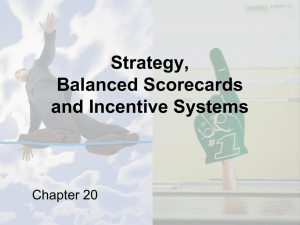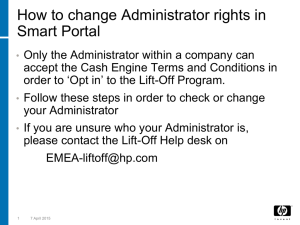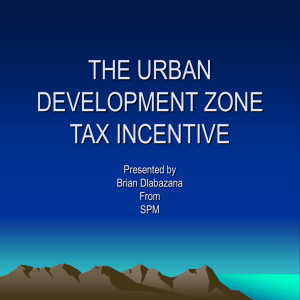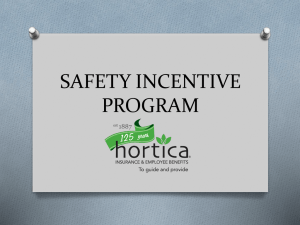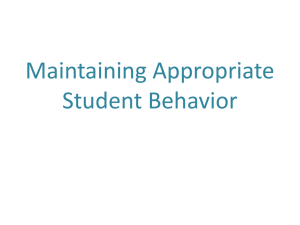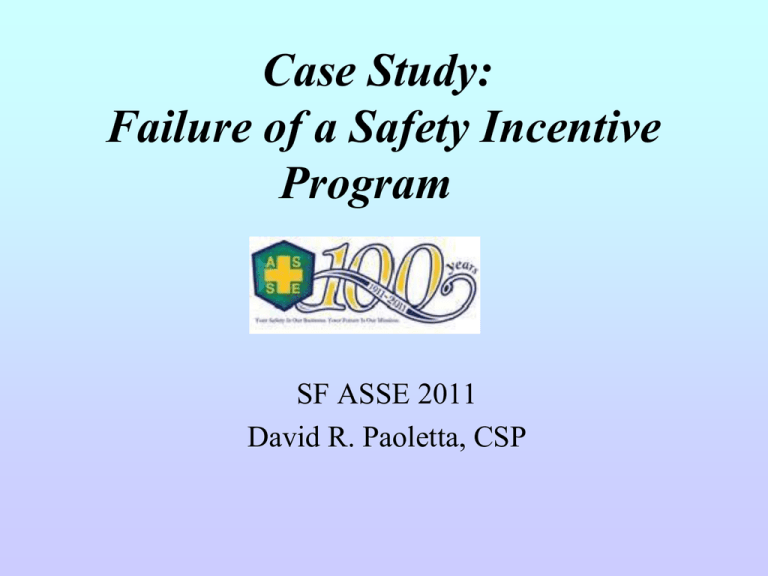
Case Study:
Failure of a Safety Incentive
Program
SF ASSE 2011
David R. Paoletta, CSP
Agenda
• Psychological and Management
Theories
• Shopping for an Incentive Program
• Case Study of a Failed Incentive
Program
• Conclusion: Motivation Vs Incentives
“ It is difficult to overestimate the extent to
which most managers and the people
who advise them believe in the
redemptive power of rewards.”
-
Alfie Kohn, Why Incentive Plans Cannot Work”, Harvard Business Review, 1993
Introduction
The goal of any workplace
Safety Program is to raise
awareness of hazards and
eliminate unsafe behaviors
that can result in injuries
and process failures.
Introduction
Typical Safety Programs consist of:
Action elements• Inspections
• Observation and Feedback
• Hazard control
• Job hazard analysis
• Safety meetings
• Accident investigations
Administrative elements• Safety Manual (procedures and guidelines)
• Committees and coordinators
• Reporting and Recordkeeping
• Training,
• Interest and motivation
Richard W. Lack 1996
Introduction
Rewarding positive historical safety statistics
is the most common design for the majority
of incentive/motivation programs.
Psychological and Management Theories
Safety Incentive/Motivation Programs may include:
• Reward and recognition for individual acts that
promote safety
• Reward and recognition of outstanding safety
program performance
• Incentive programs to promote desired behavior
• Reward and recognition for longevity – i.e. time
without an injury (Plant, team, individual…)
Psychological and Management Theories
2 Major Theories of Employee Behavior:
1. Operant Conditioning per Edward Thorndike,
John Watson, B. F. Skinner.
2. Behavioral theories per Frederick Herzberg,
William Ouchi, J. Scott Geller, Thomas Krause.
Psychological and Management Theories
Skinner's basic principle of operant conditioning:
"A response followed by a reinforcer is
strengthened and is therefore more likely to
occur again."
Psychological and Management Theories
How to increase safe behavior through Motivation
and Positive culture:
Fredrick Herzberg:
“..motivators were the primary
cause of satisfaction, and hygiene
factors the primary cause of
unhappiness on the job.”
Safety Incentive Programs
Seven Common Approaches to Safety Incentives/ Motivation*
1.
2.
3.
4.
5.
6.
7.
Motivational speakers, meetings
Slogans, posters and signs
KITA: Kick In The Pants (Coercion)
Disciplinary Action (Threats)
Gain sharing programs (Bribery)
Contests, awards and incentives
Employee participation in process improvement
* Adapted from T. R. Krause
“Motivating Employees for Safety Success” Professional Safety,
March 2000
Birth of an Incentive Program
“My boss just came back from a conference
with an idea for me to set up an incentive
program…”
http://community.blr.com/safety/forums/thread/40.aspx
Case Study of a Safety Incentive
Program
Case Study/Proposed Program
Example Company’s Program Goals:
• Sustain Success: To increase awareness and make
employee involvement part of the new culture of safety…
• Demonstrate Commitment: Statement by Management
that safe behaviors are valued to the point of committing
significant resources…
Internal company memo
Case Study/Proposed Program
• Develop “Critical Mass”: The effort to reshape the
company’s Safety culture must become personal, visible
and real to a “critical mass” of leaders and employees.
• Build the Safety Culture: This program coupled with
other initiatives will yield permanent behavior changes
necessary to correct the company’s culture.
Internal company memo
Case Study
But Which program?
•
•
•
•
•
Poster programs
Individual incentives
Work group –level incentives
Lottery systems
Incentives for time without accidents
Informal Survey of Incentive Systems
“Safety Pays” A daily “bingo” drawing in
which the “pot” grows until an OSHA
recordable injury occurs.
Claims prevention and safety suddenly takes on a whole new meaning to
the employee who's holding a bingo card that's one number away from
winning him a significant amount of money!
http://www.safetypays.com
Informal Survey of Incentive Systems
Customized solutions…
Company safety issues differ greatly; that means successful incentives take
these differences into account. We consider the problems unique to your
organization, the demographics of your workforce and the best methods to
deliver results.
http://www.incentiveprograms.com
Informal Survey of Incentive Systems
”Do It Yourself” Example 1:
Establish a "Bonus Pool" at the beginning of the yeardeduct money for:
• Safety Audit deficiencies
• OSHA Recordable injuries
At the end of the year, the balance is split up among
employees…
http://community.blr.com/safety/forums/thread/40.aspx
Informal Survey of Incentive Systems
”Do It Yourself” Example 2:
Team Vs Team…each team works to have no
accidents or injuries.
http://community.blr.com/safety/forums/thread/40.aspx
Informal Survey of Incentive Systems
”Do It Yourself” Example 3:
•
•
•
Print "Safety Bucks" at the beginning of the year- award
bucks for:
Safety suggestions
Hazard recognition
Attending safety training
Award small prizes on a quarterly basis…
http://community.blr.com/safety/forums/thread/40.aspx
Informal Survey of Incentive Systems
“Do It Yourself” Example 4:
Establish a Safety Improvement Suggestion Program:
• Safety Committee judges suggestions
Awards the individual or team with the best submission…
http://community.blr.com/safety/forums/thread/40.aspx
The Proposed Program
The “Safety Jackpot” approach was approved
for a 1 Yr pilot program:
• Promotes supervisor/worker communication
• Self-service administration
• Individuals could choose prizes
• Program operates continuously
• Incentives for every worker in company
• Positive reinforcement
http://www.safetyjackpot.com/
The Proposed Program
The challenge was how to make “Safety Jackpot” fair,
inclusive, promote safe behaviors and fun.
•
•
•
•
A list of rewards for behaviors was generated
A cash drawing was added to “spice up the pot”
Field and administrative employees participate
A budget of up to $ 400,000 was approved by upper
management
Proposed Program
The “Safety Jackpot” program details:
• 3400 employees at 98 locations
• Baseline Yr Recordable injuries: 102
• Baseline Yr WC Costs: $260,000
Proposed Program
The “Safety Jackpot” program details:
• Program Cost: $117/employee or
$398,000
• Projected savings: $488,000 direct and indirect
injury cost (assumes achievement of estimated
reductions)
• Net Projected savings: $90,000 (includes 35%
reduction in ORI)
Ref: internal memo: “The Case for Rewards and Recognition in the Development of a Best in Class Safety Culture”
Proposed Program
Projected Cost Savings for Yr 1 Due to Reduced
Injuries: $280,000.
Current and Forcast ORIR YR1
Optimum Goal,
3.7
4
3.5
WC C o st s, 2 0 0 5 , 2 0 0 6 ( P r o j e c t e d )
3.42
3.68 3.64
3.42
3.62
3.26
3.29
Recordable Case Rate
3.1
3.38
$ 600, 000
3.19
3.34
3.18
3
$ 500, 000
2.5
YR 2 Goal, 2.9
$ 487, 235
YR1 Forecast
$ 400, 000
2
YR 3 Goal, 2.0
1.5
$ 300, 000
$ 260, 000
1
$ 200, 000
Jan
Feb
Mar
Apr
May
Jun
Jul
Aug
Sep
Oct
Nov
Dec
$ 100, 000
$0
Company internal document.
2005
2006*
* P r oj ec t ed. Cos t as of J un 30: $ 86019
Proposed Program
The “Safety Jackpot” program roll-out:
• Work-group level meetings
• Information packages and catalogs sent to each
employee
• Video on company web site
• Program Web page & toll-free number available for
questions
Safety Jackpot Program
Example Roll-out marketing materials:
Jackpot Step 1
Examples or behavior to be rewarded:
• Attend Safety Meetings +1
• Be observed with correct PPE +1
• Identify Safety Hazard + 2
Managers & Supervisors will
distribute game cards to reward
safe behavior.
• Participate in site audit +3
• Lead safety training/meeting +2
• Report near miss +3
• Good Samaritan acts +3
• Coordinate safety project +4
• Obtain workstation ergo assessment +2
• Provide accepted safety suggestion +1
Jackpot Step 2
1) Scratch the silver boxes on top of
gamecard to reveal award points. The
points, (25, 50, 75 or 100), are later
redeemed for brand name merchandise.
2) The bottom half of the gamecard
reveals one of the seven letters– J-A-C-KP-O-T. Employees may trade cards to spell
JACKPOT. When spelled, they will receive
1,000 bonus points toward merchandise
and be entered into a Special Cash
Drawing.
Or…
If “ENTRY” is revealed, you will be
entered into a Special Cash Drawing (Biannual $500 to $10,000).
Jackpot Step 3
Jackpot Step 4
Additional order
forms are
available from
your supervisor
or the Safety
Staff.
Merchandise is
sent directly to
your home!
Jackpot Step 5
Program Results
• $200,000 expended
• Initial (Yr 1) ORI: 3.32
• YTD ORI when program suspended: 4.14
• Union employees from one location ripped up
cards and mailed them to the company CEO
Program Results
• Union employees refused to accept cards or collected
them and gave them to a single employee
• Overall only 20% of employees participated
• Employees perceived program as “something for
nothing” and of no tangible benefit to them.
• Program was scrapped after 9 months
Failure Analysis
• Lack of of leadership commitment at all levels.
• Supervisors needed to drive the program, and
promote it to their people. Managers needed to
drive supervisors, etc. None of that happened.
• Managers and supervisors saw it as a burden,
employees saw it as "something for nothing",
and senior management hoped for the best.
Failure Analysis
• No employee (or Union) involvement in
developing or deploying the program
• Not all areas of the company participated
directly in roll-out of program (I.e. ineffective
start-up)
• Lack of understanding of program intent and
goals
Failure Analysis
• Lack of understanding of how to redeem prizes
• Card distribution guidelines not
understood/complied with by Supervisors
• Underlying cultural issues (distrust) not
engaged prior to initiating the program.
Conclusions
• The Safety Jackpot program is not suitable for
"jump starting" a safety culture.
• The company was counting on it to replace
real cultural change initiatives, and it clearly
isn't the tool for that.
Theoretical Basis for Failure
“…findings suggest that the failure of any given
incentive program is due less to a glitch in that
program than to the inadequacy of the
psychological assumptions that ground all such
plans.”
- Alfie Kohn
Ref: Kohn, A. “Why Incentive Plans Cannot Work” Harvard Business Review. 2002.
HBR OnPoint © 2002 by Harvard Business School Publishing Corporation. All rights reserved.
Theoretical Basis for Failure
According to Research by Kohn:
Pay doesn’t motivate.
Over 70 studies have found that rewards tend to
undermine interest in the task (or behavior) itself;
this is one of the most thoroughly replicated
findings in the field of social psychology.
Kohn, A. “Why Incentive Plans Cannot Work” Harvard Business
Review. 2002. & “Challenging Behaviorist Dogma” Compensation
and Benefits Review. March/April 1998.
Theoretical Basis for Failure
-
-
Like punishments, rewards are manipulative
Rewards rupture relations. Research shows
that excellence depends on teamwork…
Rewards ignore reasons, incentive plans offer
a one-size-fits-all answer that ignores what
lies behind sub-par performance.
Rewards deter risk-taking, the No. 1 casualty
of rewards is creativity.
Kohn, A. “For Best Results, Forget the Bonus” New York Times. 10/17/1993.
If not an Incentive Program…then WHAT?
Job Enrichment
• Increase individuals’ accountability for their work
by removing some controls.
• Give people responsibility for a complete process or
unit of work.
• Make information available directly to employees
rather than sending it through their managers first.
• Enable
people to take on new, more difficult
tasks they haven’t handled before.
• Assign individuals specialized tasks that
allow them to become experts.
Ref: Herzberg, Frederick “The Motivation to Work”.
2 C’s of Quality
1. Choice: Workers participate in making
decisions about what they do.
2. Collaboration: Workers should be able to work
together in effective teams
3. Content: Refers to a job’s tasks. To do a good
job, people need a good job to do.
Kohn, A. “For Best Results, Forget the Bonus” New York Times. 10/17/1993.
Job Enrichment
- Pay people well
- Pay people fairly
- Then do everything possible to take money off
people’s minds.
Kohn, A. “For Best Results, Forget the Bonus” New York Times. 10/17/1993.
Conclusion
Safety Incentive plans are a precision tool that
can be used to fine tune an already
successful safety culture – not a crow bar to
leverage poor performance.
THANK YOU!
QUESTIONS???
David R. Paoletta, MS, MBA, CSP
drpaoletta@gmail.com




